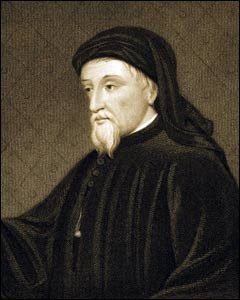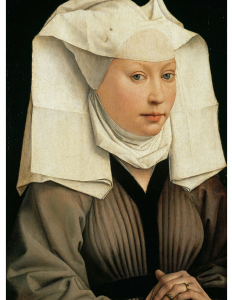Midterm Study Guide English 205
- The word medieval comes from the term middle age
- Satire is the use of sarcasm, criticism, or exaggeration in denouncing or finding fault with something
- Sympathetic attraction is the connection between heavenly and earthly bodies
- Physiognomy is that people act how they look, such as an ugly person being very mean and dumb
- An allegory is a story or poem that can be interpreted to have a hidden meaning
- Effect of piety (imagining the body of Christ)
- The Wanderer
- It is a piece of Anglo-Saxon literature
- The main character is a warrior who has lost his lord and comrades in battle, he is terribly lonely and dwells on the past when he was happy.
- He attempts to reach out and find salvation through God.
- The Canterbury Tales
- Written by Geoffrey Chaucer
- The Tales were supposed to be 120 stories but we only have 24 stories because Chaucer died before finishing
- The Canterbury Tales are Estate Satire because they make fun of the abuses of the estates of this time
- There are three states during the medieval period
- The first is the Church, or those who prayed
- The second would be the nobility, such as knights or other fighters
- The third and lowest estate would be the peasantry
- Women had estates based on sexual status: virgin, married, and widow
- The characters of the Canterbury Tales
- The narrator (Chaucer)
- The Knight, a chivalrous and morally upstanding person. He is the father to the Squire and employer of the Yeoman
- The Squire, son of the Knight, handsome and a flirt
- The Yeoman, dressed in green uses bows and daggers
- The Prioress, quiet, polite, dainty. Speaks incorrect French
- The Monk, enjoys hunting more than doing religious things
- The Friar, enjoys spending time in taverns with women and wealthy people, dislikes spending time with the poor and sick
- The Merchant, appears wealthy but is poor and in debt
- The Clerk, spends all his money on books
- The Sergeant of Law, a lawyer who seems to be pretty good at his job
- The Franklin, jovial landowner and good host
- The Tradesmen, a group of five men who represent the new social class starting to form
- The Cook, a good cook but has a large ulcer on his leg
- The Shipman, a mean thug who is good at navigating
- The Physician, an intelligent man who always knows how to cure his patients
- The Plowman, a man who works in the fields and is nice and religious
- The Parson, brother of the Plowman and who takes his job seriously and always helps the poor and sick
- The Wife of Bath, a widower who has been married several times
- The Miller, A big man who is loud and enjoys drinking
- The Manciple, purchases food and supplies for a school and is dishonest
- The Reeve, a manager who steals from his lord
- The Pardoner, sells church pardons and likes money
- The Miller’s Tale
- This story is told by the Miller, who is drunk, and is a very humorous tale.
- It is about a student named Nicholas having an affair with Alisoun. Nicholas tricks Alisoun’s husband John into hiding in a boat, while he sleeps with Alisoun. However, a parish clerk named Absolon arrives and sticks John in the rear with a hot poker after being humiliated by him and Alisoun.
- The Faerie Queen
- Written by Edmund Spenser, an English poet
- In this story, the Red Cross Knight is instructed by Queen Elizabeth to go forth and kill a dragon. Along the way he encounters monsters and an evil wizard. He eventually finds and kills the dragon.
- Gulliver’s Travels
- Written by Jonathan Swift, an Anglo-Irish writer and satirist
- Gulliver’s Travels is considered satire
- It begins with Lemuel Gulliver getting shipwrecked and ending up on an island called Lilliput
- The people who inhabit this island are roughly the size of a person’s index finger
- They tie Gulliver up and shoot his with arrows, this is only a minor nuisance to Gulliver
- He is given food and taken to their capital
- The king and his court decide not to kill Gulliver because of the stench his body would create and the fear of the plague
- The kingdom of Lilliput is at war with their neighbors over which way is the correct way to crack an egg
- He steals ships from the rival kingdom
- He flees Lilliput after he is to be sentenced to death for putting out a fire by urinating on it
- He later ends up in a land of giants called Brobdingnag
- The people here are famers and are less militant than the people of Lilliput
- Gulliver is exhibited for money by a farmer who finds him
- He is the purchased by the queen
- He talks with the king and is ashamed at how uncivilized England sounds when he tells the king about it
- Julian of Norwich is an English writer who had 16 religious visions that she received while being incredibly ill and near death
- Margery Kempe was an English Christian mystic
- She wrote an autobiography called “The Book of Margery Kempe”
- She is a very religious person who wishes to sleep in different beds from her husband so that she can be chaste and grow closer to god
- She goes on a pilgrimage to Jerusalem and cries the entire time, annoying everyone
- She wishes to marry God
- John Donne, an English poet who wrote “The Altar” and “Easter Wings” along with other works
- Says that man is not an island but is all part of one great continent
- Henry Vaughn, English poet
- In his work “Cock-Crowing” he talks about how man is calling out to God and that every time the sun rises mankind is rejuvenated
- Richard Crawshaw, English Poet
- More gruesome than Henry Vaughn’s work
- The wounds he talks about Christ having are on his eyes and his mouth
- The wounds show emotion with his eyes crying blood and his mouth kissing things
- Lacerations also look like mouths





